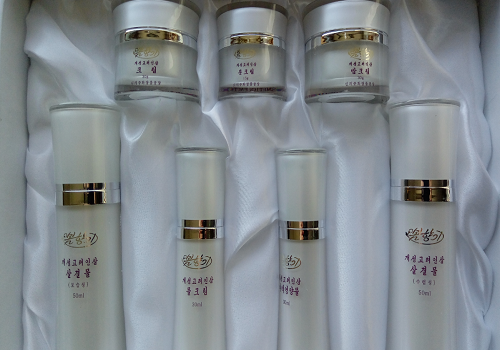 Makeup manufactured in Kaesong is gaining popularity throughout North Korea. Image: Daily NK |
Unification Media Group (UMG): North Korean merchants and traders have in recent times begun promoting wedding-related products and services throughout the year as the country moves away from seasonal wedding traditions. Instead of working with wedding planners, people in the North typically put together their own preparations, which involves going to the market to purchase items themselves. Special correspondent Kang Mi Jin joins us again to discuss the contemporary wedding market in North Korea.
Kang Mi Jin (Kang): Last week, I witnessed another wonderful couple begin a new chapter in their life. I have attended many weddings since arriving in South Korea, and have seen many significant differences to North Korean weddings. While in South Korea, one can hire a company to plan and carry out every last detail of their wedding, people in the North still prepare everything themselves, and it’s the market that provides everything they need.
The expression you can find “anything but cats’ horns” at the markets is used to mean that one can find just about anything there. This includes wedding-related items, of course – everything from gifts for the bride and groom to the items needed for the actual ceremony.
UMG: Can you tell us more about the gifts for the bride and groom and how they are presented?
Kang: Depending on personal preference, wedding items can be bought in either department stores, professional tailor shops, or the markets – which have for the most part taken over the other options as the primary source. Unlike in South Korea, people do not go through wedding planner services, but rather they pick out all items themselves. The rental market has taken off recently, but many still purchase items as well.
In North Korea, the bride normally wears a traditional hanbok (called joseon ot in North Korea) and the groom wears a suit. The groom’s family purchases and prepares the bride’s hanbok and other gifts beforehand and presents them to the bride at an engagement ceremony. Sometimes the groom has the hanbok measured, adjusted, and finished before presenting it to the bride, while other times he will present all of the materials needed to make the final product. He will also include makeup or other desired items. With weddings in spring, late fall, and even early winter, the items typically differ according to the season. These days, merchants endeavor to keep up to date with the popular items and have them in stock for their customers.
UMG: Which items are most popular these days?
Kang: I recently spoke with a woman from North Hamgyong Province who visited Chongjin’s Sunam Market in preparation for her younger sibling’s wedding. Back when I got married in North Korea, earrings or bracelets were not typical wedding gifts, but she told me that these are now popular items. Some people are able to receive South Korean appliances from family members who have already defected to the South, which make for particularly special wedding gifts. South Korean hanbok are also highly sought after.
I was able to send several hanbok to a relative in North Korea during the winter a few years ago. I’ll never forget how excited she was, telling me she absolutely could not wait for spring to arrive so she could wear her new hanbok. South Korean hanbok have really become quite popular. Of course makeup has also become an important wedding gift. New makeup products are being introduced to the market all the time these days, and women have their own preferences on what kind of makeup they would like to receive for their wedding.
UMG: Do the bride and groom exchange rings at their wedding in North Korea?
Yes, there are wedding rings in North Korea. However, the groom gives the ring to the bride at the engagement ceremony, and the groom typically does not receive or wear a ring himself – perhaps a vestige of a much older, feudal culture. But yes, it has become common for women to wear wedding rings.
UMG: Could you also tell us more about the prices of wedding items in the markets these days?
Kang: The price for a wedding hanbok first depends on the shape, design, materials, and other aspects. Chinese-made hanbok are very popular in the market, but South Korean hanbok are being imported through China now, too. These South Korean hanbok are more expensive than brand new Chinese ones. Throughout most of North Hamgyong Province at least, cheaper Chinese hanbok go for around 1 million KPW (~$125 USD), while the more expensive ones may be sold for 1.6 million KPW (~$200 USD).
Hanbok made in North Korea using velvet fabric are cheaper by comparison at 260,000 KPW (~$32). The parents typically wear these hanbok at weddings. I was told about a woman living in the border region who was able to receive a South Korean hanbok. People from the area who heard about it actually made a special trip to check it out for themselves. A person would have to pay 2.5 million KPW (~$312) to buy one, so you can understand the interest from her neighbors. As for the groom, now that it’s winter, he must also prepare warm clothes to wear under the suit jacket, so these items are also flying off the shelves these days.
UMG: It seems that the bride’s wedding attire receives the most attention, and the markets are an important resource for wedding participants to prepare their outfits. Thank you for once again informing us about the latest market trends!
 Prices are shown in KPW and current as of November 27, 2017. |

















